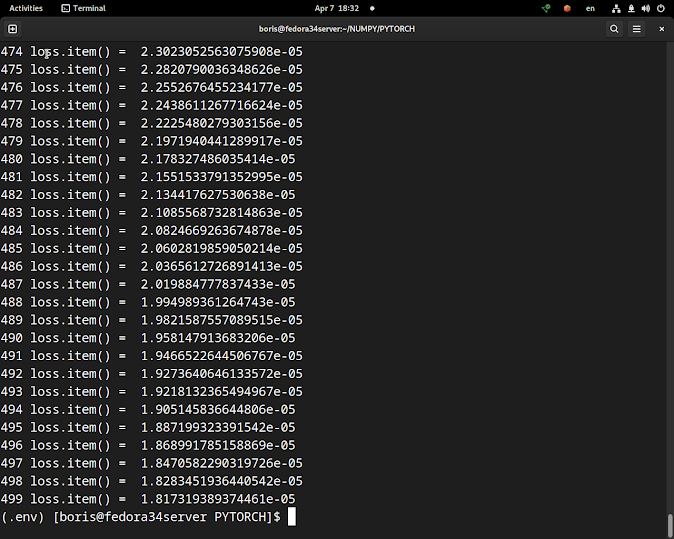Полносвязная сеть ReLU с одним скрытым слоем и без смещений, обученная предсказывать y по x путем минимизации квадрата евклидова расстояния.
Эта реализация вычисляет прямой проход, используя операции с переменными PyTorch, и использует автоградацию PyTorch для вычисления градиентов.
Переменная PyTorch представляет собой оболочку вокруг тензора PyTorch и представляет узел в вычислительном графе. Если x — переменная, то x.data — это тензор, задающий свое значение, а x.grad — другая переменная, содержащая градиент x по отношению к некоторому скалярному значению.
PyTorch Variables имеют тот же API, что и тензоры PyTorch: (почти) любую операцию, которую вы можете выполнять с тензором, вы также можете выполнять с переменной; разница в том, что autograd позволяет автоматически вычислять градиенты.
**************
Code 1
**************
(.env) [boris@fedora34server PYTORCH]$ cat pyTorch1.py
import torch
from torch.autograd import Variable
dtype = torch.FloatTensor
# dtype = torch.cuda.FloatTensor # Uncomment this to run on GPU
# N is batch size; D_in is input dimension;
# H is hidden dimension; D_out is output dimension.
N, D_in, H, D_out = 64, 1000, 100, 10
# Create random Tensors to hold input and outputs, and wrap them in Variables.
# Setting requires_grad=False indicates that we do not need to compute gradients
# with respect to these Variables during the backward pass.
x = Variable(torch.randn(N, D_in).type(dtype), requires_grad=False)
y = Variable(torch.randn(N, D_out).type(dtype), requires_grad=False)
# Create random Tensors for weights, and wrap them in Variables.
# Setting requires_grad=True indicates that we want to compute gradients with
# respect to these Variables during the backward pass.
w1 = Variable(torch.randn(D_in, H).type(dtype), requires_grad=True)
w2 = Variable(torch.randn(H, D_out).type(dtype), requires_grad=True)
learning_rate = 1e-6
for t in range(500):
# Forward pass: compute predicted y using operations on Variables; these
# are exactly the same operations we used to compute the forward pass using
# Tensors, but we do not need to keep references to intermediate values since
# we are not implementing the backward pass by hand.
y_pred = x.mm(w1).clamp(min=0).mm(w2)
# Compute and print loss using operations on Variables.
loss = (y_pred - y).pow(2).sum()
# Use autograd to compute the backward pass. This call will compute
# the gradient of loss with respect to all Variables with requires_grad=True.
# After this call w1.grad and w2.grad will be Variables holding the gradient
# of the loss with respect to w1 and w2 respectively.
loss.backward()
# Update weights using gradient descent; w1.data and w2.data are Tensors,
# w1.grad and w2.grad are Variables and w1.grad.data and w2.grad.data are
# Tensors.
w1.data -= learning_rate * w1.grad.data
w2.data -= learning_rate * w2.grad.data
print("w1.data = ",w1.data)
print("w1.grad.data = ",w1.grad.data)
# Manually zero the gradients after updating weights
w1.grad.data.zero_()
w2.grad.data.zero_()








No comments:
Post a Comment